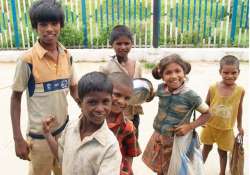India's rank improves to 55th position on global hunger index
New Delhi: The number of hungry people has declined in India with its score on the Global Hunger Index improving to 55th position in 2014 due to progress made in addressing underweight in children, says

New Delhi: The number of hungry people has declined in India with its score on the Global Hunger Index improving to 55th position in 2014 due to progress made in addressing underweight in children, says a report.
The country's score is better than Pakistan (rank 57) and Bangladesh (57) but it still trails behind Nepal (44) and Sri Lanka (39).
India was at 63rd position on GHI last year.
"Progress in dealing with underweight helped India's 2014 GHI score fall to 17.8 points. India now ranks 55th out of 76 countries, before Bangladesh and Pakistan, but still trails behind neighbouring Nepal and Sri Lanka," the report said.
While the country is no longer in the "alarming" category, India's hunger status is still classified as "serious," it said.
While India has made significant progress in reducing underweight among children under five in the past few years, "much work still needs to be done" at the national and state levels so that a greater share of the population will enjoy nutrition security, it suggested.
The GHI report has been jointly prepared by International Food Policy Research Institute and NGOs Welthungerhilfe and Concern Worldwide.
This year marks the end of a "data drought", the report said, adding that India has determined its first new provisional national underweight estimate in eight years.
At 30.7 per cent, it points to real progress compared with the last estimate of 43.5 per cent in 2005–2006, it said.
"As a consequence, India no longer ranks second to last on underweight in children, but 120th among 128 countries with data on child undernutrition from 2009–2013," it added.
Highlighting the efforts made to address underweights in India, the report said that since the last undernutrition data became available, the Indian government rolled out and expanded several programmes that targeted a mix of direct and inidrect causes of undernutrition.
Nutrition-specific interventions that were scaled up after 2006 include a final push to expand the Integrated Child Development Services and the launch of the National Rural Health Mission.
Indirect factors may have included the National Rural Employment Guarantee Scheme, a rural jobs programme, and reforms in several states to the Public Distribution System, which distributes food to the poor, the report said.
The GHI report said: "Although implementation of these social sector programmes has been fairly uneven across India's diverse states, given the scale and budget of these programs in India, it is likely that changes have helped improve underlying conditions for child growth in parts of India."
It said efforts have also been made to create an enabling environment for nutrition. Within the context of India's decentralised governance system, state governments have taken ownership of nutrition and tried to strengthen delivery of targeted nutrition efforts.
"The state of Maharashtra was the first of several to bring high-level political and bureaucratic leadership to nutrition through a Nutrition Mission, a program with greater flexibility and freedom than usual," said the report.
Another key element in the enabling environment for food security and nutrition was the creation of a body called the Commissioners to the Supreme Court on the Right to Food Act, a group that supports independent monitoring of the delivery of food-based programs like the Integrated Child Development Services programme and the PDS, it added.